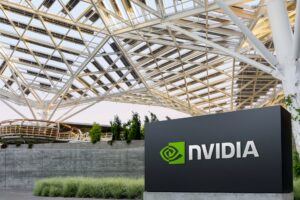Nvidia Corp. (NVDA, Financial) is no doubt heading the artificial intelligence (AI) revolution and has solidly staked its claim of being part of accelerated computing. This is evident from the current stock price of Nvidia which has gone up by a staggering 183.4% over the past year. This speaks volumes of the market appreciation of the company’s innovation especially the Blackwell GPUs which are poised to transform the AI infrastructure for years to come.
That said, Nvidia has had some short-term challenges, which stemmed from production issues during the Blackwell ramp-up. This placed some pressure but did not take away from the fact that the company has demonstrated its capacity to scale production and stabilize margins, and more importantly, they have done so in a remarkably resilient way.
Above all, the company demonstrates a smart innovation pipeline and strong financial performance, hence it has the potential to grow exponentially. I see Nvidia’s stock going up to $155-$160 in the near term as both revenues and margins are expected to rise further with Blackwell production increasing by FY2025. In the long term, the stock may go up to the $200-$225 level because of continued market expansion, healthy financial returns, and operational excellence.
Nvidia is located in Santa Clara, California, as one of the world’s largest and most innovative companies based on accelerated computing and AI. The company was started in 1993 and invented the GPU in 1999. This GPU was a stalwart that transformed computer graphics, accelerated the gaming industry, and was the precursor to current AI and high-performance computing (HPC).
Today, Nvidia controls many industries ranging from gaming and professional visualization to data centers, autonomous vehicles, and robots. It scales over 75% of the TOP500 supercomputers globally and has a vibrant ecosystem of over 5.5 million developers.
Not only that, but Nvidia’s strengths in both chips and software, as well as full-stack computing make it the pioneer behind technologies like generative AI, accelerated computing, and AI factories in the present advanced digital transformation. Nvidia today is a company with more than 30,000 employees and it is still actively contributing to further development of computing technologies.
When looking at Nvidia’s innovations, they remain crucial to its growth. One of the latest is Nvidia AI Workbench which enables fast creation and customization of generative AI models. On the hardware front, Nvidia introduced the GB200 NVL72 system, a remarkable AI infrastructure for trillion-parameter models with superior performance.
The chart below shows that NVIDIA’s GB200 NVL72 GPU shows a 30 times rise in real-time throughput and four times faster model training than HGX H100 for GPT-MoE-1.8T models. This performance further cements Nvidia’s position in the AI hardware markets and draws more customers from data centers, cloud providers, and research institutions. The Blackwell GPU launch has also brought major performance and cost optimizations, which I will discuss in the following section of this article.
Source: Company Website
Further, the rise of geopolitical threats is addressed by Nvidia’s diversification into new AI markets including India and Japan. CSPs in India such as Tata Communications (TATACOM, Financial) and Infosys (INFY, Financial) have increased GPU deployment by nearly tenfold in a year. Along the same line, the collaborations with Japanese behemoths such as SoftBank (SFTBY, Financial) to construct the AI supercomputer reinforce Nvidia’s position in the Asia-Pacific region. These actions open up new markets for the company’s sustainable and rich revenues.
Although Nvidia’s recent pullback arises from concerns about its gross margin pressures together with the scalability of Blackwell GPUs, this consolidation phase provides a good entry point for long-term investors and a turning point for Nvidia. Gross margins are expected to lower to 71-72.5% due to initial production challenges but then projected to increase to mid-70% by late FY2025 as adoption increases and production becomes more efficient.
Blackwell GPUs transform AI infrastructure with 2.2 times better performance and up to 4 times greater cost efficiency over Hopper GPUs. This efficiency is due to improvements in compute throughput and memory architecture allowing for GPT-3 benchmarks to be run with fewer GPUs thereby reducing operating costs. Major players such as Oracle (ORCL, Financial) already utilize Blackwell-powered AI clusters, making it imperative to the development of future AI. This underlines the company’s outstanding progress in cost optimization and operational resilience.
Nvidia reported exceptional third-quarter 2025 results with total revenues up by a whopping 94% year-over-year (YOY) to $35.1 billion. The Data Center segment showed standout performance, recording a YOY increase of 112%, reaching $30.8 billion, due to the rising popularity of the Hopper H200 GPUs. Cloud Service Providers also accounted for nearly half of the Data Center revenue, which underlines the necessity of AI infrastructure in cloud facilities throughout North America, EMEA, and APAC regions.
The following chart proves the company’s consistent revenue increase from $18.1 billion in Q3 2024 to $35.1 billion in Q3 2025, owing to the high demand for AI-focused products by Nvidia.
Source: Nvidia’s Q3 FY25 Investor Presentation
In addition to that, the company has seen operating expenses rise from the higher levels of R&D in Blackwell production and other minor margin fluctuations, but still gross margins remained at 75%. This efficiency clearly pointed to the fact that the company was growing and at the same time remained profitable. Not only that, but the net income has risen to $19.3 billion, which is 109% higher YOY while operating cash flow hit a record $17.6 billion, a 140% increase YOY.
In the future, Nvidia estimates Q4 revenue of $37.5 billion, driven by continuous demand for Hopper and the initial Blackwell ramp. While there are some headwinds in the short term, this quarter re-establishes Nvidia as the AI and accelerated computing giant that is perfect for long-term, growth-oriented investors to consider.
Nvidia’s forward price-to-sales (P/S) ratio of 27.23 times and price-to-earnings (P/E) ratio of 51.1 times might seem high, but the growth narrative is well worth the premium valuation. Since the AI wave started off in late 2022, Nvidia has been consistently setting up new milestones in terms of revenue generation. These metrics help to present Nvidia as not only a tech company but as an amplifier of the AI revolution.
The company has staggering gross margins, suggesting that it operates on a relatively stable cost structure despite the challenges. Current margin pressures result from Nvidia’s aggressive innovation cycle which is, as mentioned earlier, envisioned to moderate in the second half of 2025.
Moreover, Nvidia’s growth performance and forward trajectory also provide us with more compelling evidence about the company’s premium valuation, making it absolutely valid. The company’s revenue and earnings-per-share (EPS) growth metrics are quite impressive and compelling, which significantly exceed sector averages. Nvidia has achieved an incredible YOY revenue growth of 152.44% which is more than 3,500% higher than the sector median. Consequently, the diluted EPS growth YOY is also impressive at 234% and indubitably positions Nvidia as the leader in AI computation.
Source: Author Generated Based on Data
For full-year (FY) 2025, the EPS is expected to rise by a whopping 127.89% YOY to $2.95, thereby giving it the added impetus to soar in its two burgeoning segments.
While Nvidia has a great growth narrative, risks remain. The primary issue is related to the decrease of margins during product transitions. The Blackwell ramp has negative effects on production and increases onboarding costs which can reduce the company’s short-term profitability. In terms of downside risks, there are still a few concerns with the Blackwell chips. For instance, some of the problems experienced in Nvidia’s Blackwell AI chips include overheating when used on servers.
At the same time, there is an issue of geopolitical risk for Nvidia, namely its operations in China. These risks are well exemplified by the current strained relations between the U.S. and China through the restrictions placed on Nvidia’s superior GPU exports to China and the increasing use of domestic products such as Huawei chips. Previously, and to a significant extent now, China is one of the major markets for NVDA. For example, in 2021, the company had 25% exposure to its China market, which has now more than halved to 12%.
Nvidia’s growth prospects remain promising. Generative AI is still in its initial phase, and businesses are increasingly using AI tools to improve their processes while governments are investing in AI systems. These constant changes indicate that Nvidia’s business will continue to grow at an aggressive rate for many years.
Although there are some short-term weaknesses, including production issues during the Blackwell ramp-up, margin volatility, and geopolitical issues, Nvidia’s strength and resilience are what define it. Moreover, the company’s wonderful quarterly results and products such as Blackwell GPUs strengthen its position in the industry.
Finally, the ability of Nvidia to exceed more than $200 in the long run as mentioned in the investment thesis is supported by its innovations, geographical diversification, and high financial and EPS growth. Drawing such strong fundamentals, Nvidia seems to be the perfect company for investors who want to seize this future behind AI.
This article first appeared on GuruFocus.








